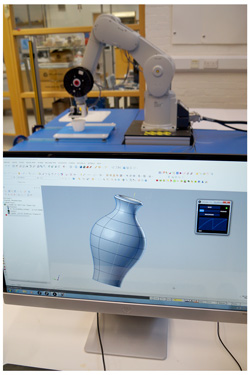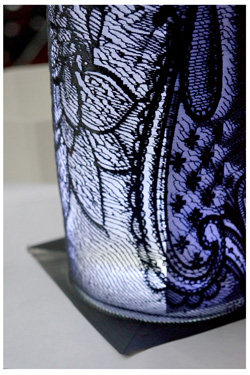Six-axis robot turns 3D printing into an art form
There is a current project underway at the Centre for Fine Print Research (CFPR) which is looking at 3D printing from a totally different angle - where the emphasis is placed on meaningful expression, rather than the accurate reproduction of digital data, and at the centre of the project lies a flexible Mitsubishi Electric MELFA RV-7FLM articulated arm industrial robot.
Additive Manufacturing (3D printing) is increasingly being used in the manufacturing industry for prototyping, low volume manufacture and for making items with complex shapes which cannot easily be reproduced by other means. The main challenge is posed by complex geometry; when an object is to be fabricated, the shape must be broken down into a series of machine tool paths that will accumulate material by building up layers in a stable and reliable way.
For this reason, 3D printing is generally a very precisely controlled process, both in terms of the type of movement (steady acceleration and velocity) and the deposition of materials. In industrial applications, material is deposited or fused in small quantities. The machines are accordingly operated in a logical, numerical way, just as in CNC machining.
 Conversely, the Centre for Fine Print Research (CFPR) project is looking at 3D printing from the viewpoint of the Arts, where the emphasis is placed on meaningful expression. A good analogy to the project would be the potter’s wheel, where the artist works in direct contact with clay and with an intimate understanding of the constraints of working the material and the wheel in synergy.
Conversely, the Centre for Fine Print Research (CFPR) project is looking at 3D printing from the viewpoint of the Arts, where the emphasis is placed on meaningful expression. A good analogy to the project would be the potter’s wheel, where the artist works in direct contact with clay and with an intimate understanding of the constraints of working the material and the wheel in synergy.
Here, the artist is able to express something with the material, often pushing the material to its limits, for example by generating sweeping elegant forms, or revealing new material qualities, such as translucency. The CFPR has background expertise in ceramics, photo-cure resins and thermoplastics, all of which are being investigated with the new robotic platform. Previous work has evaluated the 3D printer as a tool to manipulate materials, or produce unusual surface textures, as opposed to simply using it as a machine that reproduces digital models at a fine resolution.
Using a printer in 'unusual ways' means moving beyond simply using CAD models and slicing algorithms, as these are too automated. By writing proprietary software, it is possible to develop printing methods from the point of view of how the material can be expressively played with.
In order to achieve this shifted perspective, the project is using a Mitsubishi Electric MELFA RV-7FLM robot arm to research technologies and techniques to sense and manipulate materials in a dynamic way, rather than deposit them in fixed, rigid or ‘machine-like’ ways. The robot is running printer paths defined by proprietary software and requires a high degree of automation and real-time responsiveness.
"By pushing 3D printable materials to their limits, we have exposed unexpected properties in the materials," said Dr Paul O'Dowd, Research Fellow - Creative Electronics and Engineering. "For instance, plastic deposition can be manipulated whilst it is hot and pulled into hairs, or fine gauss, or woven. Ceramics can also be deposited so that the material composition is capable of self-glazing in a single firing (as opposed to a multiple firing process). These material states may have applications in wider industry."
The task of robotically manipulating materials through complex states - for example, sensing and responding to viscosity - requires the integration of several advanced technologies. The MELFA RV-7FLM allows real-time control and provides a reliable programming interface to allow this to happen. It also has a large area of reach and movement for a compact robot arm.
"The Mitsubishi Electric robot arm is very dexterous, allowing the robot to manipulate materials from all directions," continued O'Dowd. "Conventionally 3D Printers are machines with three linear axis (XYZ) and fabrication occurs in fixed horizontal layers. But the RV-F Series robot arm has both freedom of movement and a comprehensive set of expansion capabilities, including pneumatics and digital I/O, which are cleanly integrated into the chassis of the arm itself. This makes for an attractive combination of force control, movement range (908mm reach) and reliability, while also being at the right price point."
Proprietary software is being developed which must respond very quickly and dynamically to changes in the material’s properties and the construction of the printed object. This means that the control program cannot be rigid in its operation. Instead it must constantly and iteratively interpret its working task environment and autonomously correct its behaviour.
Commenting on his selection of the Mitsubishi Electric robot, Dr O’Dowd said: "We researched several robot manufacturers before deciding on the Mitsubishi Electric model, we were looking for flexibility of movement as well as an open programming environment. What really decided it for us though was the affordability of the robot package and the level of support provided by Mitsubishi Electric. We were invited to the UK HQ to assess a robot and have received excellent technical support throughout the project. As the robot is pushed further we will continue to call on training and advice as we need it."










